Noninvasive measure of microvascular nitric oxide function in humans using very low-frequency cutaneous laser Doppler flow spectra
- PMID: 17454670
- PMCID: PMC4513357
- DOI: 10.1080/10739680601139179
Noninvasive measure of microvascular nitric oxide function in humans using very low-frequency cutaneous laser Doppler flow spectra
Abstract
Objective: While higher frequency oscillations (0.021-0.6 Hz) in cutaneous blood flow measured by laser Doppler flowmetry (LDF) relate to oscillations in blood pressure and sympathetic nerve activity, very low-frequency oscillations (VLF, 0.0095-0.021 Hz) do not. The authors investigated whether VLF LDF power is nitric oxide (NO) specific.
Methods: LDF combined with intradermal microdialysis was used in the calves of 22 healthy volunteers aged 19-27 years. LDF power spectral analysis was performed by windowed fast Fourier transform. The authors tested whether the NO synthesis inhibitor nitro-l-arginine (NLA) produced selective decreases in VLF power before and after stimulation with acetylcholine.
Results: NLA alone did not alter total power but selectively reduced VLF power by approximately 50%. LDF and spectral power increased markedly across all spectra with acetylcholine. This increase was blunted by NLA, which selectively reduced VLF power by approximately 50%.
Conclusions: The data suggest that VLF oscillations in the laser Doppler signal are NO dependent, increase with cholinergic stimulation, and have potential as a noninvasive marker for NO-dependent microvascular reactivity.
Figures
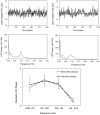
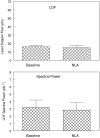

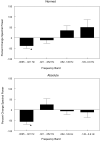
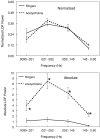

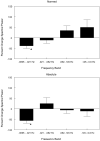
Similar articles
-
Nitric oxide and prostaglandin inhibition during acetylcholine-mediated cutaneous vasodilation in humans.Microcirculation. 2008 Aug;15(6):569-79. doi: 10.1080/10739680802091526. Microcirculation. 2008. PMID: 18696360 Free PMC article.
-
Low-frequency oscillations of the laser Doppler perfusion signal in human skin.Microvasc Res. 2006 Nov;72(3):120-7. doi: 10.1016/j.mvr.2006.05.006. Epub 2006 Jul 18. Microvasc Res. 2006. PMID: 16854436
-
Blunted increase of digital skin vasomotion following acetylcholine and sodium nitroprusside iontophoresis in systemic sclerosis patients.Rheumatology (Oxford). 2008 Jul;47(7):1012-7. doi: 10.1093/rheumatology/ken117. Epub 2008 Apr 22. Rheumatology (Oxford). 2008. PMID: 18430760
-
Contributions of endothelial nitric oxide synthase, noradrenaline, and neuropeptide Y to local warming-induced cutaneous vasodilatation in men.Microvasc Res. 2013 Nov;90:128-34. doi: 10.1016/j.mvr.2013.08.011. Epub 2013 Sep 6. Microvasc Res. 2013. PMID: 24012636
-
Laser Doppler flowmetry in manual medicine research.J Am Osteopath Assoc. 2014 Dec;114(12):908-17. doi: 10.7556/jaoa.2014.178. J Am Osteopath Assoc. 2014. PMID: 25429081 Review.
Cited by
-
Biological Effects of Magnetic Storms and ELF Magnetic Fields.Biology (Basel). 2023 Dec 8;12(12):1506. doi: 10.3390/biology12121506. Biology (Basel). 2023. PMID: 38132332 Free PMC article. Review.
-
Low-frequency blood flow oscillations in congestive heart failure and after beta1-blockade treatment.Microvasc Res. 2008 Nov;76(3):224-32. doi: 10.1016/j.mvr.2008.07.006. Epub 2008 Aug 5. Microvasc Res. 2008. PMID: 18721820 Free PMC article.
-
Vasomotion analysis of speed resolved perfusion, oxygen saturation, red blood cell tissue fraction, and vessel diameter: Novel microvascular perspectives.Skin Res Technol. 2022 Jan;28(1):142-152. doi: 10.1111/srt.13106. Epub 2021 Nov 10. Skin Res Technol. 2022. PMID: 34758168 Free PMC article.
-
The contribution of sensory nerves to cutaneous vasodilatation of the forearm and leg to local skin heating.Eur J Appl Physiol. 2015 Oct;115(10):2091-8. doi: 10.1007/s00421-015-3188-7. Epub 2015 May 22. Eur J Appl Physiol. 2015. PMID: 25998144
-
The phase coherence of the neurovascular unit is reduced in Huntington's disease.Brain Commun. 2024 Jun 10;6(3):fcae166. doi: 10.1093/braincomms/fcae166. eCollection 2024. Brain Commun. 2024. PMID: 38938620 Free PMC article.
References
-
- Funk W, Endrich B, Messmer K, Intaglietta M. Spontaneous arteriolar vasomotion as a determinant of peripheral vascular resistance. Int J Microcirc Clin Exp. 1983;2:11–25. - PubMed
-
- Mayer S. Studien zur physiologie des herzens und der blutgefässe. V. Ueber spontane blut-druckschwankungen. Akad Wiss Wien Math Nat Kl. 1876;74:281–307.
-
- Braverman IM, Keh A, Goldminz D. Correlation of laser Doppler wave patterns with underlying microvascular anatomy. J Invest Dermatol. 1990;95:283–286. - PubMed
Publication types
MeSH terms
Substances
Grants and funding
LinkOut - more resources
Full Text Sources

